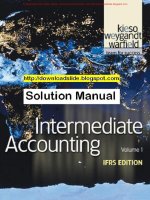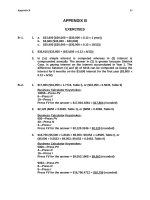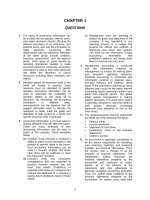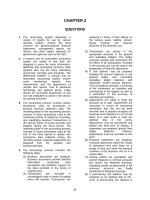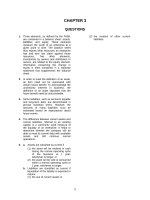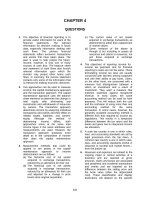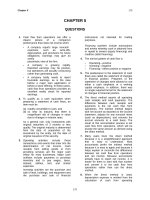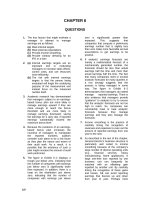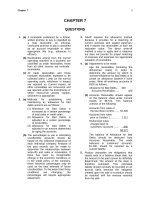Solution manual intermediate accounting 7th by nelson spiceland ch08
Bạn đang xem bản rút gọn của tài liệu. Xem và tải ngay bản đầy đủ của tài liệu tại đây (563.39 KB, 79 trang )
Find more slides, ebooks, solution manual and testbank on www.downloadslide.com
Chapter 8
Inventories: Measurement
AACSB assurance of learning standards in accounting and business education require
documentation of outcomes assessment. Although schools, departments, and faculty may approach
assessment and its documentation differently, one approach is to provide specific questions on
exams that become the basis for assessment. To aid faculty in this endeavor, we have labeled each
question, exercise, and problem in Intermediate Accounting, 7e, with the following AACSB learning
skills:
Questions
AACSB Tags
Exercises (cont.)
AACSB Tags
8–1
8–2
8–3
8–4
8–5
8–6
8–7
8–8
8–9
8–10
8–11
8–12
8–13
8–14
8–15
8–16
Reflective thinking
Reflective thinking
Reflective thinking
Reflective thinking
Reflective thinking
Reflective thinking
Reflective thinking
Reflective thinking
Reflective thinking
Reflective thinking
Reflective thinking
Reflective thinking
Reflective thinking
Reflective thinking
Reflective thinking
Reflective thinking
8–5
8–6
8–7
8–8
8–9
8–10
8–11
8–12
8–13
8–14
8–15
8–16
8–17
8–18
8–19
8–20
8–21
8–22
8–23
8–24
Analytic
Analytic
Analytic
Analytic
Analytic
Analytic
Analytic
Communications
Analytic
Analytic
Analytic
Analytic
Analytic
Analytic
Analytic
Communications
Analytic
Analytic
Analytic
Reflective thinking
Brief Exercises
8–1
8–2
8–3
8–4
8–5
8–6
8–7
8–8
8–9
8–10
8–11
8–12
8–13
Analytic
Analytic
Analytic
Analytic
Analytic
Analytic
Analytic
Analytic
Analytic
Analytic
Analytic
Analytic
Analytic
Exercises
8–1
8–2
8–3
8–4
Solutions Manual, Vol.1, Chapter 8
Analytic
Analytic
Analytic
Analytic
CPA/CMA
1
2
3
4
5
6
7
8
1
2
3
Analytic
Analytic
Analytic
Analytic
Analytic
Analytic
Analytic
Reflective thinking
Analytic
Analytic
Analytic
Problems
8–1
8–2
Analytic
Analytic
© The McGraw-Hill Companies, Inc., 2013
8–1
Find more slides, ebooks, solution manual and testbank on www.downloadslide.com
Problems cont.
AACSB Tags
8–3
8–4
8–5
8–6
8–7
8–8
8–9
8–10
8–11
8–12
8–13
8–14
8–15
8–16
Analytic
Analytic
Analytic
Analytic
Analytic
Analytic
Analytic
Analytic
Analytic
Analytic
Analytic
Analytic
Analytic
Analytic
© The McGraw-Hill Companies, Inc., 2013
8–2
Intermediate Accounting, 7/e
Find more slides, ebooks, solution manual and testbank on www.downloadslide.com
QUESTIONS FOR REVIEW OF KEY TOPICS
Question 8–1
Inventory for a manufacturing company consists of (1) raw materials, (2) work in process, and
(3) finished goods. Raw materials represent the cost, primarily purchase price plus freight charges,
of goods purchased from other manufacturers, that will become part of the finished product. Workin-process inventory represents the products that are not yet complete. The cost of work in process
includes the cost of raw materials used in production, the cost of labor that can be directly traced to
the goods in process, and an allocated portion of other manufacturing costs, called manufacturing
overhead. When the manufacturing process is completed, these costs that have been accumulated in
work in process are transferred to finished goods.
Question 8–2
Beginning inventory plus net purchases for the period equals cost of goods available for sale.
The main difference between a perpetual and a periodic system is that the periodic system allocates
cost of goods available for sale to ending inventory and cost of goods sold only at the end of the
period. The perpetual system accomplishes this allocation by decreasing inventory and increasing
cost of goods sold each time goods are sold.
Question 8–3
Perpetual System
Periodic System
(1) Purchase of merchandise
debit inventory
debit purchases
(2) Sale of merchandise
debit cost of goods sold;
credit inventory
no entry
(3) Return of merchandise
credit inventory
credit purchase returns
(4) Payment of freight
debit inventory
debit freight-in
Question 8–4
Inventory shipped f.o.b. shipping point is included in the inventory of the purchaser when the
merchandise reaches the common carrier. Laetner Corporation records the purchase in 2013 and
includes the shipment in its ending inventory. Bockner Company records the sale in 2013.
Inventory shipped f.o.b. destination is included in the inventory of the seller until it reaches the
purchaser’s location. Bockner would include the merchandise in its 2013 ending inventory and the
sale/purchase would be recorded in 2014.
Solutions Manual, Vol.1, Chapter 8
© The McGraw-Hill Companies, Inc., 2013
8–3
Find more slides, ebooks, solution manual and testbank on www.downloadslide.com
Answers to Questions (continued)
Question 8–5
A consignment is an arrangement under which goods are physically transferred to another
company (the consignee), but the transferor (consignor) retains legal title. If the consignee can’t
find a buyer, the goods are returned to the consignor. Goods held on consignment are included in
the inventory of the consignor until sold by the consignee.
Question 8–6
By the gross method, purchase discounts not taken are viewed as part of inventory cost. By the
net method, purchase discounts not taken are considered interest expense because they are viewed as
compensation to the seller for providing financing to the buyer.
Question 8–7
1. Beginning inventory
2. Purchases
3. Ending inventory
4. Purchase returns
5. Freight-in
—
—
—
—
—
increase
increase
decrease
decrease
increase
Question 8–8
Four methods of assigning cost to ending inventory and cost of goods sold are (1) specific
identification, (2) first-in, first-out (FIFO), (3) last-in, first-out (LIFO), and (4) average cost. The
specific identification method requires each unit sold during the period or each unit on hand at the
end of the period to be traced through the system and matched with its actual cost. First-in, first-out
(FIFO) assumes that units sold are the first units acquired. The last-in, first-out (LIFO) method
assumes that the units sold are the most recent units purchased. The average cost method assumes
that cost of goods sold and ending inventory consist of a mixture of all the goods available for sale.
The average unit cost applied to goods sold or ending inventory is an average unit cost weighted by
the number of units acquired at the various unit prices.
Question 8–9
When costs are declining, LIFO will result in a lower cost of goods sold and higher income
than FIFO. This is because LIFO will include in cost of goods sold the most recently purchased
lower-cost merchandise. LIFO also will provide a higher ending inventory in the balance sheet.
© The McGraw-Hill Companies, Inc., 2013
8–4
Intermediate Accounting, 7/e
Find more slides, ebooks, solution manual and testbank on www.downloadslide.com
Answers to Questions (continued)
Question 8–10
Proponents of LIFO argue that it provides a better match of revenues and expenses because
cost of goods sold includes the costs of the most recent purchases. These are matched with sales that
reflect a current selling price. On the other hand, inventory costs in the balance sheet generally are
out of date because they are derived from old purchase transactions. It is conceivable that a
company’s LIFO inventory balance could be based on unit costs actually incurred several years
earlier. When inventory quantity declines during a period, then these out-of-date inventory layers
will be liquidated and cost of goods sold will match noncurrent costs with current selling prices.
Question 8–11
Many companies choose the LIFO inventory method to reduce income taxes in periods when
prices are rising. In periods of rising prices, LIFO results in a higher cost of goods sold and
therefore a lower net income than the other methods. The companies’ income tax returns will report
lower taxable incomes using LIFO and lower taxes will be paid currently. If a company uses LIFO
to measure its taxable income, IRS regulations require that LIFO also be used to measure income
reported to investors and creditors.
Question 8–12
The gross profit, inventory turnover, and average days in inventory ratios are designed to
monitor inventories. The gross profit ratio is calculated by dividing gross profit (net sales minus
cost of goods sold) by net sales. Inventory turnover is calculated by dividing cost of goods sold by
average inventory, and we compute average days in inventory by dividing the number of days in the
period by the inventory turnover ratio.
Question 8–13
A LIFO inventory pool groups inventory units into pools based on physical similarities of the
individual units. The average cost for all of a pool’s beginning inventory and for all of a pool’s
purchases during the period is used instead of individual unit costs. If the quantity of ending
inventory for the pool increases, then ending inventory will consist of the beginning inventory plus a
layer added during the period at the average acquisition cost for the pool.
Question 8–14
The dollar-value LIFO method has important advantages. First, it simplifies the recordkeeping
procedures compared to unit LIFO because no information is needed about unit flows. Second, it
minimizes the probability of the liquidation of LIFO inventory layers, even more so than the use of
pools alone, through the aggregation of many types of inventory into larger pools. In addition, firms
that do not replace units sold with new units of the same kind can use the method.
Solutions Manual, Vol.1, Chapter 8
© The McGraw-Hill Companies, Inc., 2013
8–5
Find more slides, ebooks, solution manual and testbank on www.downloadslide.com
Answers to Questions (concluded)
Question 8–15
After determining ending inventory at year-end cost, the following steps remain:
1. Convert ending inventory valued at year-end cost to base year cost.
2. Identify the layers in ending inventory with the years they were created.
3. Convert each layer’s base year cost measurement to layer year cost measurement using the
layer year’s cost index and then sum the layers.
Question 8–16
The primary difference between U.S. GAAP and IFRS in the methods allowed to value
inventory is that IFRS does not allow the use of the LIFO method.
© The McGraw-Hill Companies, Inc., 2013
8–6
Intermediate Accounting, 7/e
Find more slides, ebooks, solution manual and testbank on www.downloadslide.com
BRIEF EXERCISES
Brief Exercise 8–1
Beginning inventory
Plus: Purchases
Less: Cost of goods sold
Ending inventory
$186,000
945,000
(982,000)
$149,000
Brief Exercise 8–2
To record the purchase of inventory on account.
Inventory ......................................................................... 845,000
Accounts payable........................................................
845,000
To record sales on account and cost of goods sold.
Accounts receivable........................................................ 1,420,000
Sales revenue ..............................................................
1,420,000
Cost of goods sold .......................................................... 902,000
Inventory.....................................................................
902,000
Solutions Manual, Vol.1, Chapter 8
© The McGraw-Hill Companies, Inc., 2013
8–7
Find more slides, ebooks, solution manual and testbank on www.downloadslide.com
Brief Exercise 8–3
Both shipments should be included in inventory. The goods shipped to a
customer f.o.b. destination did not arrive at the customer’s location until after the
fiscal year-end. They belong to Kelly until they arrive at the customer’s location.
Title to the goods shipped from a supplier to Kelly on December 30, f.o.b. shipping
point, changed hands on December 30.
Brief Exercise 8–4
Purchase price = 10 units x $25,000 = $250,000
December 28, 2013
Inventory ......................................................................... 250,000
Accounts payable ........................................................
250,000
January 6, 2014
Accounts payable ............................................................ 250,000
Cash (99% x $250,000) ...................................................
247,500
Inventory (1% x $250,000) .............................................
2,500
© The McGraw-Hill Companies, Inc., 2013
8–8
Intermediate Accounting, 7/e
Find more slides, ebooks, solution manual and testbank on www.downloadslide.com
Brief Exercise 8–5
December 28, 2013
Inventory (99% x $250,000) ............................................... 247,500
Accounts payable .......................................................
247,500
January 6, 2014
Accounts payable............................................................ 247,500
Cash ............................................................................
247,500
Solutions Manual, Vol.1, Chapter 8
© The McGraw-Hill Companies, Inc., 2013
8–9
Find more slides, ebooks, solution manual and testbank on www.downloadslide.com
Brief Exercise 8–6
Cost of goods available for sale:
Beginning inventory (200 x $25)
Purchases:
100 x $28
200 x $30
Cost of goods available (500 units)
$5,000
$2,800
6,000
8,800
$13,800
First-in, first-out (FIFO)
Cost of goods available for sale (500 units)
Less: Ending inventory (determined below)
Cost of goods sold
$13,800
(8,100)
$5,700
Cost of ending inventory:
Date of
purchase
January 8
January 19
Total
Units
75
200
Unit cost
$28
30
Total cost
$2,100
6,000
$8,100
Average cost
Cost of goods available for sale (500 units)
Less: Ending inventory (determined below)
Cost of goods sold
$13,800
(7,590)
$6,210 *
Cost of ending inventory:
$13,800
Weighted-average unit cost =
= $27.60
500 units
275 units x $27.60 = $7,590
* Alternatively, could be determined by multiplying the units sold by the average
cost: 225 units x $27.60 = $6,210
© The McGraw-Hill Companies, Inc., 2013
8–10
Intermediate Accounting, 7/e
Find more slides, ebooks, solution manual and testbank on www.downloadslide.com
Brief Exercise 8–7
First-in, first-out (FIFO)
Cost of goods sold:
Date of
Sale
January 10
January 25
Total
Cost of
Units Sold
Units Sold
125 (from Beg. Inv.)
75 (from Beg. Inv.)
25 (from 1/8 purchase)
225
Ending inventory:
Date of
Purchase
Units
January 8
75
January 19
200
Total
Solutions Manual, Vol.1, Chapter 8
Unit Cost
$28
30
$25
25
28
Total Cost
$3,125
1,875
700
$5,700
Total Cost
$2,100
6,000
$8,100
© The McGraw-Hill Companies, Inc., 2013
8–11
Find more slides, ebooks, solution manual and testbank on www.downloadslide.com
Brief Exercise 8–7 (concluded)
Average cost
Date
Purchased
Beginning
inventory
200 @ $25
=
$5,000
January 8
100 @ $28
=
$2,800
Available
Sold
Balance
200 @ $25
$5,000
125 @ $26 = $3,250 175 @ $26
$4,550
$7,800
= $26/unit
300 units
January 10
January 19
200 @ $30 =
Available
$10,550
$6,000
= $28.133/unit
375 units
100 @ $28.133 = $2,813 275 @ $28.133
January 25
Total cost of goods sold
© The McGraw-Hill Companies, Inc., 2013
8–12
$7,737
Ending
inventory
= $6,063
Intermediate Accounting, 7/e
Find more slides, ebooks, solution manual and testbank on www.downloadslide.com
Brief Exercise 8–8
Cost of goods available for sale:
Beginning inventory (20,000 x $25)
Purchases:
80,000 x $30
Cost of goods available (100,000 units)
Less: Ending inventory (15,000 units)
Cost of goods sold
$ 500,000
2,400,000
2,900,000
375,000*
$2,525,000
*15,000 units x $25 each = $375,000
Brief Exercise 8–9
64,000 units were sold.
Cost of goods sold without year-end purchase:
Units purchased during the year: 60,000 x $18
Plus units from beginning inventory: 4,000 x $15
Cost of goods sold
$1,080,000
60,000
1,140,000
Cost of goods sold with year-end purchase:
64,000 units x $18
Difference
1,152,000
$ 12,000
Cost of goods sold would be $12,000 higher and income before income taxes
$12,000 lower if the year-end purchase is made.
If FIFO were used instead of LIFO, the year-end purchase would have no effect
on income before income taxes. FIFO cost of goods sold with or without the purchase
would consist of the 10,000 units from beginning inventory and 54,000 units
purchased during the year at $18:
10,000 units x $15
Plus: 54,000 units x $18
Cost of goods sold
Solutions Manual, Vol.1, Chapter 8
$ 150,000
972,000
$1,122,000
© The McGraw-Hill Companies, Inc., 2013
8–13
Find more slides, ebooks, solution manual and testbank on www.downloadslide.com
Brief Exercise 8–10
Units liquidated
Difference in cost ($30 – 25)
Before-tax LIFO liquidation profit
Tax effect ($25,000 x 40%)
LIFO liquidation profit
5,000
x $5
$25,000
(10,000)
$15,000
Brief Exercise 8–11
Cost of goods sold for the fiscal year ended February 26, 2011, would have been
$18 million lower had SuperValue used FIFO for its LIFO inventory. While
beginning inventory would have been $264 million higher, ending inventory also
would have been higher by $282 million. An increase in beginning inventory causes
an increase in cost of goods sold, but an increase in ending inventory causes a
decrease in cost of goods sold. Purchases for the year are the same regardless of the
inventory valuation method used.
Cost of goods sold as reported
Decrease if FIFO
Cost of goods sold, FIFO instead of LIFO
© The McGraw-Hill Companies, Inc., 2013
8–14
$29,124 million
(18) million
$29,106 million
Intermediate Accounting, 7/e
Find more slides, ebooks, solution manual and testbank on www.downloadslide.com
Brief Exercise 8–12
Average inventory = ($60,000 + 48,000) y 2 = $54,000
Cost of goods sold y Average inventory = Inventory turnover
Cost of goods sold y $54,000 = 5
Cost of goods sold = $54,000 x 5
Cost of goods sold = $270,000
Gross profit ratio = 40%, therefore cost percentage = 60%
Sales x .60 = $270,000
Sales = $270,000 y .60 = $450,000
Brief Exercise 8–13
Date
Ending Inventory
at Base Year Cost
1/1/13
$1,400,000
Inventory Layers
at Base Year Cost
Inventory Layers
Converted to Cost
Inventory
DVL Cost
= $1,400,000
$1,400,000 (base)
$1,400,000 x 1.00 =$1,400,000
$1,400,000
$1,664,000
= $1,600,000
1.04
$1,400,000 (base)
200,000 (2013)
$1,400,000 x 1.00 = $1,400,000
200,000 x 1.04 =
208,000
$1,608,000
1.00
12/31/13
Solutions Manual, Vol.1, Chapter 8
© The McGraw-Hill Companies, Inc., 2013
8–15
Find more slides, ebooks, solution manual and testbank on www.downloadslide.com
EXERCISES
Exercise 8–1
1.
2.
To record the purchase of inventory on account and the payment of freight
charges.
Inventory .........................................................................
Accounts payable ........................................................
5,000
Inventory .........................................................................
Cash .............................................................................
300
300
To record purchase returns.
Accounts payable ............................................................
Inventory .....................................................................
3.
5,000
600
600
To record cash sales and cost of goods sold.
Cash .................................................................................
Sales revenue...............................................................
5,200
Cost of goods sold ...........................................................
Inventory .....................................................................
2,800
© The McGraw-Hill Companies, Inc., 2013
8–16
5,200
2,800
Intermediate Accounting, 7/e
Find more slides, ebooks, solution manual and testbank on www.downloadslide.com
Exercise 8–2
1.
2.
To record the purchase of inventory on account and the payment of freight
charges.
Purchases ........................................................................
Accounts payable........................................................
5,000
Freight-in ........................................................................
Cash ............................................................................
300
300
To record purchase returns.
Accounts payable............................................................
Purchase returns..........................................................
3.
5,000
600
600
To record cash sales.
Cash ................................................................................
Sales revenue ..............................................................
5,200
5,200
NO ENTRY IS MADE FOR THE COST OF GOODS SOLD.
Solutions Manual, Vol.1, Chapter 8
© The McGraw-Hill Companies, Inc., 2013
8–17
Find more slides, ebooks, solution manual and testbank on www.downloadslide.com
Exercise 8–3
Requirement 1
Beginning inventory
Plus net purchases:
Purchases
Less: Purchase discounts
Less: Purchases returns
Plus: Freight-in
Cost of goods available for sale
Less: Ending inventory
Cost of goods sold
$ 32,000
$240,000
(6,000)
(10,000)
17,000
241,000
273,000
(40,000)
$233,000
Requirement 2
Cost of goods sold (above) ............................................... 233,000
Inventory (ending) ............................................................ 40,000
Purchase discounts ..........................................................
6,000
Purchase returns .............................................................. 10,000
Inventory (beginning) ...................................................
32,000
Purchases .....................................................................
240,000
Freight-in .....................................................................
17,000
© The McGraw-Hill Companies, Inc., 2013
8–18
Intermediate Accounting, 7/e
Find more slides, ebooks, solution manual and testbank on www.downloadslide.com
Exercise 8–4
PERPETUAL SYSTEM
PERIODIC SYSTEM
($ in 000s)
Purchases
Inventory
Accounts payable
155
155
Freight
Inventory
Cash
10
Returns
Accounts payable
Inventory
12
Sales
Accounts receivable
Sales revenue
Cost of goods sold
Inventory
End of period
No entry
Purchases
Accounts payable
155
10
10
Freight-in
Cash
12
12
Accounts payable
Purchase returns
250
250
Accounts receivable
Sales revenue
250
148
10
12
250
No entry
148
Cost of goods sold (below)
Inventory (ending)
Purchase returns
Inventory (beginning)
Purchases
Freight-in
Cost of goods sold:
Beginning inventory
Purchases
Less: Returns
Plus: Freight-in
Net purchases
Cost of goods available
Less: Ending inventory
Cost of goods sold
Solutions Manual, Vol.1, Chapter 8
155
148
30
12
25
155
10
$25
$155
(12)
10
153
178
(30)
$148
© The McGraw-Hill Companies, Inc., 2013
8–19
Find more slides, ebooks, solution manual and testbank on www.downloadslide.com
Exercise 8–5
Beginning inventory
Cost of goods sold
Ending inventory
Cost of goods available for sale
Purchases (gross)
Purchase discounts
Purchase returns
Freight-in
2013
275 (1)
627
249 (2)
876
630
18
24
13
2014
249 (3)
621
225
846 (4)
610 (5)
15
30
32
2015
225
584 (6)
216
800
585
12 (7)
14
16
Net purchases = Purchases (gross) – Purchase returns – Purchase discounts + Freight-in
Beginning inventory + Net purchases = Cost of goods available for sale
Cost of goods available for sale – Ending inventory = Cost of goods sold
2013:
(1) Cost of goods available for sale – Net purchases = Beginning inventory
876 – (630 – 18 – 24 + 13) = 275 = Beginning inventory
(2) Cost of goods available for sale – Cost of goods sold = Ending inventory
876 – 627 = 249 = Ending inventory
2014:
(3) 2014 beginning inventory = 2013 ending inventory = 249
(4) Cost of goods sold + Ending inventory = Cost of goods available for sale
621 + 225 = 846 = Cost of goods available for sale
(5) Cost of goods available for sale – Beginning inventory = Net purchases
846 – 249 = 597 = Net purchases
Net purchases + Purchases discounts + Purchase returns – Freight-in = Purchases(gross)
597 + 15 + 30 – 32 = 610 = Purchases (gross)
2015:
(6) Cost of goods available for sale – Ending inventory = Cost of goods sold
800 – 216 = 584 = Cost of goods sold
© The McGraw-Hill Companies, Inc., 2013
8–20
Intermediate Accounting, 7/e
Find more slides, ebooks, solution manual and testbank on www.downloadslide.com
Exercise 8–5 (concluded)
(7) Cost of goods available for sale – Beginning inventory = Net purchases
800 – 225 = 575 = Net purchases
Purchases (gross) – Purchase returns + Freight-in – Net purchases = Purchase discounts
585 – 14 + 16 – 575 = 12 = Purchase discounts
Solutions Manual, Vol.1, Chapter 8
© The McGraw-Hill Companies, Inc., 2013
8–21
Find more slides, ebooks, solution manual and testbank on www.downloadslide.com
Exercise 8–6
Inventory balance before additional transactions
Add:
Goods shipped to Kwok f.o.b. shipping point on Dec. 28
Goods shipped to customer f.o.b. destination on December 27
Correct inventory balance
$165,000
17,000
22,000
$204,000
Exercise 8–7
Inventory balance before additional transactions
Add:
Merchandise on consignment with Joclyn Corp.
Deduct:
Merchandise shipped to Raymond f.o.b. destination on December 26
Merchandise held on consignment from the Harrison Company
Correct inventory balance
$210,000
15,000
(30,000)
(14,000)
$181,000
Exercise 8–8
1.
2.
3.
4.
5.
6.
7.
Excluded
Included
Included
Excluded
Included
Excluded
Included
© The McGraw-Hill Companies, Inc., 2013
8–22
Intermediate Accounting, 7/e
Find more slides, ebooks, solution manual and testbank on www.downloadslide.com
Exercise 8–9
Requirement 1
Purchase price = 1,000 units x $50 = $50,000
July 15, 2013
Purchases ........................................................................
Accounts payable........................................................
July 23, 2013
Accounts payable............................................................
Cash (98% x $50,000) ....................................................
Purchase discounts (2% x $50,000) ...............................
50,000
50,000
50,000
49,000
1,000
Requirement 2
August 15, 2013
Accounts payable............................................................
Cash ............................................................................
50,000
50,000
Requirement 3
The July 15 entry would include a debit to the inventory account instead of to
purchases, and the July 23 entry would include a credit to the inventory account
instead of to purchase discounts.
Solutions Manual, Vol.1, Chapter 8
© The McGraw-Hill Companies, Inc., 2013
8–23
Find more slides, ebooks, solution manual and testbank on www.downloadslide.com
Exercise 8–10
Requirement 1
July 15, 2013
Purchases (98% x $50,000) ................................................
Accounts payable .......................................................
49,000
July 23, 2013
Accounts payable ............................................................
Cash .............................................................................
49,000
49,000
49,000
Requirement 2
August 15, 2013
Accounts payable ............................................................
Interest expense ...............................................................
Cash .............................................................................
49,000
1,000
50,000
Requirement 3
The July 15 entry would include a debit to the inventory account instead of to
purchases.
© The McGraw-Hill Companies, Inc., 2013
8–24
Intermediate Accounting, 7/e
Find more slides, ebooks, solution manual and testbank on www.downloadslide.com
Exercise 8–11
Requirement 1
Purchases: $500 x 70% = $350 per unit.
100 units x $350 = $35,000
November 17, 2013
Purchases ........................................................................
Accounts payable........................................................
November 26, 2013
Accounts payable ...........................................................
Purchase discounts (2% x $35,000) ...............................
Cash (98% x $35,000) ....................................................
35,000
35,000
35,000
700
34,300
Requirement 2
December 15, 2013
Accounts payable............................................................
Cash ............................................................................
Solutions Manual, Vol.1, Chapter 8
35,000
35,000
© The McGraw-Hill Companies, Inc., 2013
8–25
